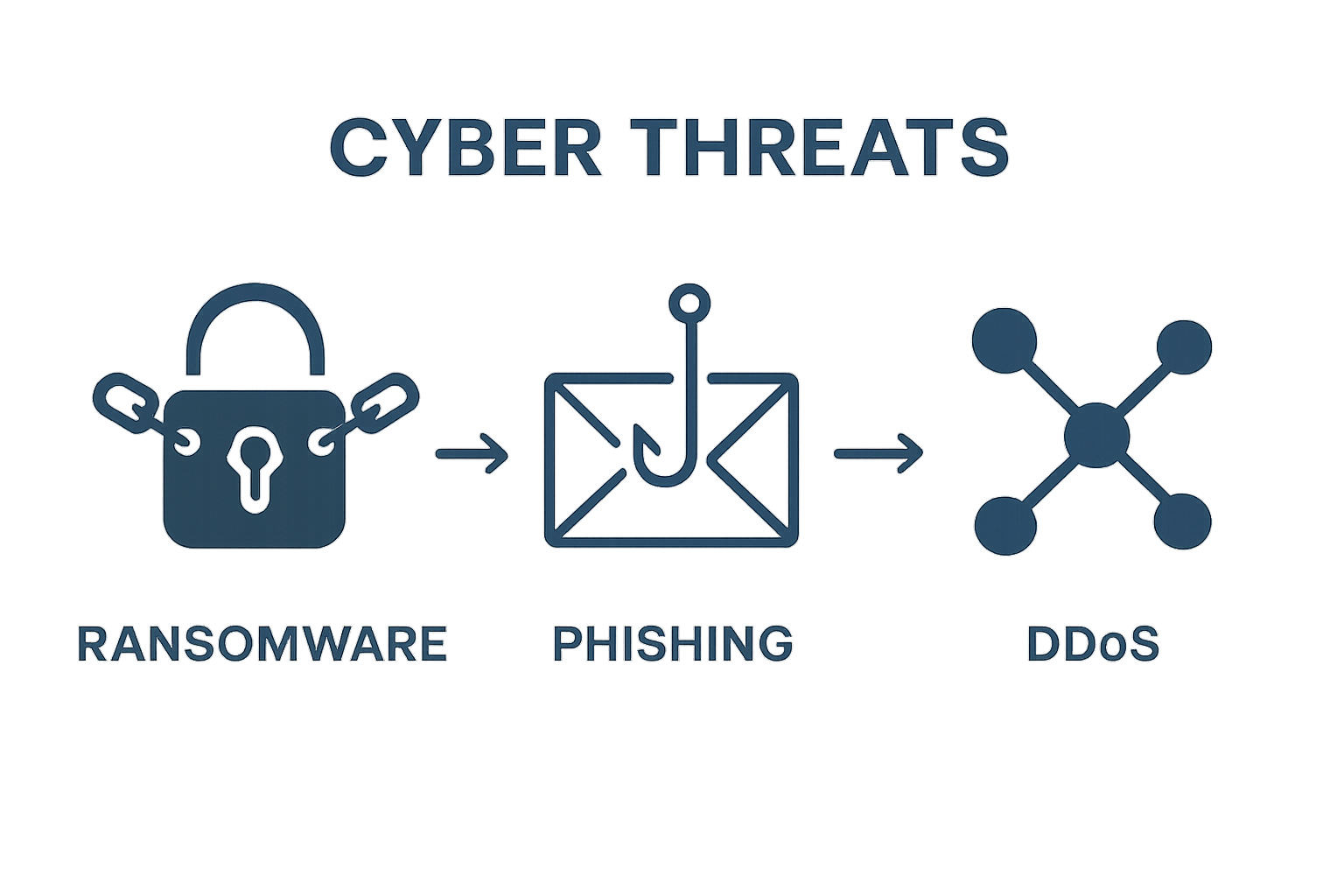Cyber threats are hitting Queensland businesses at an alarming rate. The average cyber incident can cost a small to medium business tens of thousands of dollars and that is just the beginning. Most people think cybercriminals only go after massive corporations but in reality, small businesses are at serious risk and the damage goes way beyond just financial loss.
Table of Contents
- Defining Cyber Threats: Key Concepts Explained
- The Importance of Understanding Cyber Threats
- How Cyber Threats Work: Mechanisms and Techniques
- Common Types of Cyber Threats Businesses Encounter
- Real-World Impacts of Cyber Threats on Small to Medium Enterprises
Quick Summary
| Takeaway | Explanation |
|---|---|
| Understand various cyber threats. | Recognizing the different types of threats helps in assessing vulnerability and readiness. |
| Proactive defence is essential. | Businesses must implement protective strategies to guard against sophisticated digital attacks. |
| Financial losses can be severe. | Cyber incidents can cost organizations tens of thousands of dollars, impacting sustainability. |
| Reputation management is critical. | Data breaches can lead to significant trust erosion, affecting long-term customer relationships. |
| Human factors are key attack vectors. | Social engineering techniques exploit psychological vulnerabilities, making workforce training vital. |
Defining Cyber Threats: Key Concepts Explained
Cyber threats represent malicious attempts to disrupt, damage, or gain unauthorised access to computer systems, networks, and digital infrastructure. These digital dangers pose significant risks for businesses across Queensland, potentially compromising sensitive information, financial resources, and operational stability.
Understanding Digital Attack Vectors
Cyber threats emerge through multiple channels, targeting vulnerable points in an organisation’s technological ecosystem. Learn more about cybersecurity fundamentals to comprehend how these threats operate. Digital attack vectors typically include:
- Malicious software designed to infiltrate computer systems
- Network vulnerabilities exploited by skilled cybercriminals
- Social engineering techniques manipulating human psychology
- Unauthorised access attempts targeting confidential data repositories
According to the Australian Cyber Security Centre, businesses face increasingly sophisticated digital risks that require proactive defence strategies. These threats are not random occurrences but calculated attempts to exploit technological weaknesses.
Types of Cyber Threats Businesses Encounter
Modern cyber threats manifest in various forms, each presenting unique challenges for organisational security. Ransomware attacks, for instance, involve criminals encrypting critical business data and demanding payment for restoration. Phishing schemes trick employees into revealing sensitive login credentials through deceptive communication channels.
Other prevalent cyber threats include:

- Business email compromise targeting financial transactions
- Data breaches exposing confidential customer information
- Distributed denial of service (DDoS) attacks disrupting online operations
Understanding these threat landscapes enables businesses to develop robust cybersecurity frameworks that protect digital assets and maintain operational integrity.
Below is a comparison of common types of cyber threats faced by Queensland businesses, highlighting their main features and potential impacts.
| Threat Type | Main Mechanism | Potential Impact |
|---|---|---|
| Ransomware Attack | Data encryption for ransom | Loss of access to critical data, extortion |
| Phishing Scheme | Deceptive communication | Credential theft, unauthorised access |
| Business Email Compromise | Intercepted financial transactions | Financial theft, fraudulent payments |
| Data Breach | Unauthorised access or leaks | Loss of sensitive information, fines |
| Distributed Denial of Service (DDoS) | Overwhelming network traffic | Operational downtime, loss of services |
The Importance of Understanding Cyber Threats
For businesses operating in Queensland’s dynamic digital landscape, comprehending cyber threats represents more than a technical exercise. It is a critical strategic imperative that directly impacts financial stability, reputation management, and long-term organisational resilience.
Financial and Operational Consequences
Cyber incidents can inflict devastating financial damage on businesses. Our comprehensive guide to cybersecurity threats highlights the potential economic ramifications. According to research from the Australian Cyber Security Centre, cyber attacks can result in significant monetary losses through:
- Direct financial theft
- Operational disruption
- Regulatory compliance penalties
- Expensive recovery and remediation processes
The average cyber incident for small to medium businesses can cost tens of thousands of dollars, representing a substantial risk to organisational sustainability.
Reputation and Customer Trust
Cyber threats extend beyond immediate financial losses. A single data breach can permanently erode customer confidence and damage hard-earned business reputation. Customers expect businesses to protect their sensitive information, and a security failure can trigger immediate and long-lasting trust erosion.
Business reputation is fragile. Cyber incidents can lead to:
- Loss of existing customer base
- Reduced potential for new customer acquisition
- Negative media coverage
- Potential legal consequences
Proactive understanding and management of cyber threats demonstrate professional responsibility and commitment to digital security, ultimately strengthening stakeholder relationships and organisational credibility.
The following table outlines financial and reputational consequences businesses may face after a cyber incident, aiding in risk awareness and planning.
| Consequence | Description |
|---|---|
| Revenue Loss | Immediate income reduction due to operational disruption |
| Recovery Costs | Expenses for system repair, restoration, and upgrades |
| Regulatory Penalties | Fines for not meeting compliance obligations |
| Loss of Customer Base | Existing clients switching to competitors |
| Negative Media Coverage | Public exposure of security failures affects brand image |
| Trust Erosion | Ongoing scepticism from clients and partners |

How Cyber Threats Work: Mechanisms and Techniques
Cyber threats operate through sophisticated and evolving mechanisms designed to exploit technological vulnerabilities and human psychology. Understanding these intricate techniques is crucial for businesses seeking to protect their digital infrastructure and sensitive information.
Social Engineering Tactics
Malicious actors frequently leverage psychological manipulation to breach organisational defences. Learn about critical vulnerabilities businesses must address to comprehend these complex infiltration strategies. According to research from the Australian Cyber Security Centre, social engineering techniques typically involve:
- Exploiting human trust and emotional triggers
- Creating convincing false narratives
- Impersonating trusted contacts or authority figures
- Generating a sense of urgency to prompt hasty actions
These tactics aim to circumvent technical security measures by directly targeting human decision making processes within organisations.
Technical Infiltration Methods
Cyber threats employ multiple technical approaches to penetrate digital systems. Malware represents a primary mechanism, utilizing various sophisticated delivery methods such as:
- Disguised email attachments
- Compromised website downloads
- Exploiting software vulnerabilities
- Network protocol manipulation
These technical infiltration techniques enable cybercriminals to gain unauthorized system access, extract sensitive data, or establish persistent network presence without immediate detection. Modern cyber threats frequently combine psychological manipulation with complex technical strategies, creating multifaceted attack vectors that challenge traditional security frameworks.
Common Types of Cyber Threats Businesses Encounter
Businesses in Queensland face a diverse array of cyber threats that can compromise digital infrastructure, financial stability, and organisational reputation. Understanding these specific threat types is crucial for developing robust defensive strategies.
Malware and Ransomware Attacks
Malicious software represents a significant digital danger for businesses. Explore comprehensive insights into data security challenges to understand these complex threats. According to research from the Australian Cyber Security Centre, malware variations include:
- Viruses that replicate and spread across computer systems
- Trojans disguised as legitimate software
- Spyware tracking organisational digital activities
- Ransomware encrypting critical business data
These sophisticated software threats can infiltrate systems through seemingly innocent email attachments, compromised websites, or network vulnerabilities.
Sophisticated Phishing and Social Engineering
Cybercriminals increasingly target human psychology as a primary attack vector. Phishing techniques have evolved beyond simple email scams, now incorporating complex psychological manipulation strategies:
- Highly personalized email communications
- Fake communication from trusted organisational contacts
- Urgent requests mimicking executive communication
- Sophisticated website cloning techniques
These advanced social engineering methods aim to trick employees into revealing sensitive information or performing actions that compromise organisational security, bypassing traditional technological defence mechanisms.
Real-World Impacts of Cyber Threats on Small to Medium Enterprises
Cyber threats pose substantial and potentially devastating consequences for small to medium enterprises across Queensland, extending far beyond theoretical technological risks. These digital vulnerabilities can trigger catastrophic operational and financial disruptions that threaten organisational survival.
Financial Devastation and Operational Disruption
Cyber incidents can rapidly transform into financial nightmares for businesses. Understand the critical security challenges facing modern enterprises to appreciate the potential consequences. According to research from Austrade, small businesses confronting cyber attacks frequently experience:
- Immediate revenue loss from operational interruptions
- Substantial expenses related to system recovery
- Potential legal and regulatory compliance penalties
- Long-term reputation damage reducing future business opportunities
The financial impact can be so severe that many small enterprises struggle to recover, with some ultimately forced into closure after significant cyber incidents.
Reputational and Trust Erosion
Customer confidence represents a fragile and critical business asset that cyber threats can instantly demolish. When businesses experience data breaches or security failures, the reputational consequences often extend well beyond immediate financial losses:
- Immediate customer trust deterioration
- Potential mass customer exodus
- Negative public perception and media coverage
- Challenging pathway to rebuilding organisational credibility
Qld businesses must recognise that a single cyber incident can permanently damage hard-earned market reputation, making proactive cybersecurity not just a technical requirement, but a fundamental business survival strategy.
Take Control of Cyber Threats Before They Disrupt Your Business
Every business in Brisbane faces the growing risk of cyber threats that can cripple systems, expose sensitive data, and destroy hard-earned trust. The article has shown how malware, phishing, and sophisticated social engineering tactics put your financial stability and reputation on the line. If operational downtime or the fear of a security breach is keeping you up at night, now is the time to act. You need more than just information—you need a proactive strategy, reliable protection, and expert guidance tailored for local businesses just like yours.
IT Start specialises in managed IT support and advanced cybersecurity services for Queensland businesses. We go beyond traditional support by detecting threats early, reinforcing your digital defences, and ensuring your team is always prepared. Why risk financial loss, regulatory penalties, or damaged trust when you can partner with local certified professionals who put your security first? Discover how our managed IT solutions protect businesses every day. If you want a practical, personalised approach to safeguarding your operations, request a free assessment or a no-obligation consultation now. Do not wait for an incident to become your wake-up call—secure your business with IT Start today.
Frequently Asked Questions
What are cyber threats?
Cyber threats are malicious attempts to disrupt, damage, or gain unauthorised access to computer systems and networks, posing significant risks to businesses by compromising sensitive information and operational stability.
What are some common types of cyber threats faced by businesses?
Common types of cyber threats include ransomware attacks, phishing schemes, business email compromise, data breaches, and distributed denial of service (DDoS) attacks, each presenting unique challenges to organisational security.
How do cyber threats affect a business’s reputation?
Cyber threats can severely damage a business’s reputation by eroding customer trust following data breaches or security failures, leading to loss of clients, negative media attention, and a long-term impact on organisational credibility.
Why is understanding cyber threats important for businesses?
Understanding cyber threats is crucial for businesses as it helps them develop robust cybersecurity frameworks, protect digital assets, and maintain operational integrity, ultimately ensuring financial stability and long-term organisational resilience.
Recommended
- 7 Top SMB Cybersecurity Threats Every Business Should Know – IT Start
- What is Cybersecurity? Understanding Its Importance and Function – IT Start
- What to Know About Cyber Security: Understanding Its Importance – IT Start
- Understanding Data Security Problems and Solutions – IT Start
- 10 Biggest Cybersecurity Mistakes of Small Companies



